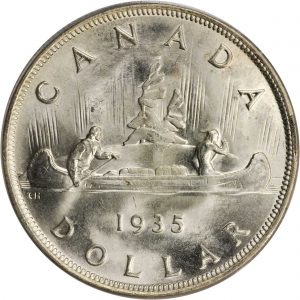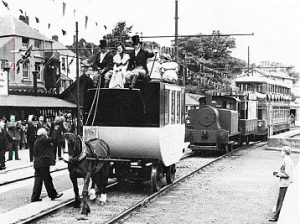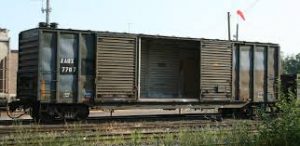Two human traits stifle technological innovation. One of them is our innate suspicion of change, and we can see how that would have worked to our advantage historically, and the other is the slightly more complicated cultural and by times financially inspired inertia. The introduction of the dollar coins, for very sound financial reasons, and the refusal to implement a faster keyboard than the QWERTY even though that would make economic sense, are a few examples of decisions that have little to do with efficiency or alacrity and much more to do with resistance to change. As well, the standard railroad track gauge has a huge economic and moral cost to society in terms of accidents and lives lost, but it persists into the modern day even when we are lying tracks for new railroads and could easily if expensively redesign the system.
Both the United States and Canada decided to make the logical choice to switch to the dollar coin rather than the paper bill, and although the reactions were in the end very different, the reactionary response tells us much about how that suspicion of change works. In the American case, they wanted to replace the dollar bill and earlier coin  attempts with the Susan B. Anthony dollar coin. For many feminist scholars—the reaction against the switch, as the outcry became loud enough to be heard by the finance sectors, and more tellingly, as many people simply refused to use the coin—was evidence of a misogynist reaction to the first currency in the country that featured a woman. Long before Susan B. Anthony was featured on American coinage, however, in 1964 the Congress tried to make a peace dollar. Some thought the coins were associated with special interest groups and the government acquiescence to their demands meant that the Coinage Act of 1965 was passed and the dollars were melted at the cost to the taxpayer. The next attempt took a task force and wasted time in the House of Representatives before the Eisenhower dollar was produced in 1970. It also suffered from neglect, as many refused to use it in their daily transactions.
attempts with the Susan B. Anthony dollar coin. For many feminist scholars—the reaction against the switch, as the outcry became loud enough to be heard by the finance sectors, and more tellingly, as many people simply refused to use the coin—was evidence of a misogynist reaction to the first currency in the country that featured a woman. Long before Susan B. Anthony was featured on American coinage, however, in 1964 the Congress tried to make a peace dollar. Some thought the coins were associated with special interest groups and the government acquiescence to their demands meant that the Coinage Act of 1965 was passed and the dollars were melted at the cost to the taxpayer. The next attempt took a task force and wasted time in the House of Representatives before the Eisenhower dollar was produced in 1970. It also suffered from neglect, as many refused to use it in their daily transactions.
The wish to produce the metal dollars was a financial one. It was estimated at the time that it would save the mint over nineteen million dollars in production of paper bills. Shortly after, the Liberty dollar design was switched with the Susan B. Anthony dollar in 1978. After six hundred thousand dollars in marketing to convince people to accept the coin and a hundred million in vending machine refitting, the coin was widely panned because it was nearly the same size as the quarter and many institutions, such as transit companies, simply refused to take it. The dollar lasted until the year 2000 until it was replaced by the Sacagawea dollar.
In Canada, the dollar coin faced similar opposition, although the government mint proved intractable and the people less obstinate about using the coin. It followed the historical voyageur dollar, from 1935, which was discontinued in 1967. Again, largely become of financial reasons, the Canadian mint began work on a new coin in 1982, partially due to pressure from vending machine operators and transit authorities. A Commons Committee thought Canadians would not support the move, but nonetheless proposed the dollar bill be discontinued and the dollar introduced. They argued that it would save the Canadian government two hundred million dollars over twenty years in paper dollar replacements costs.
voyageur dollar, from 1935, which was discontinued in 1967. Again, largely become of financial reasons, the Canadian mint began work on a new coin in 1982, partially due to pressure from vending machine operators and transit authorities. A Commons Committee thought Canadians would not support the move, but nonetheless proposed the dollar bill be discontinued and the dollar introduced. They argued that it would save the Canadian government two hundred million dollars over twenty years in paper dollar replacements costs.
The Canadian dollar was made to be compatible with American vending machines, answering the requests from interested corporations, and thus was similar in size and shape to the Susan B. Anthony dollar, but it would be gold coloured in order to distinguish it from the failed US currency attempt. The Voyageur plans had been lost in transit,  oddly, so the Mint couldn’t continue the same design as before—although it seems easy enough to make new blanks. Partially out of a fear of counterfeiting, the Mint decided to use Robert-Ralph Carmichael’s design of a loon floating on water. Almost immediately upon the coin arriving in the till—the coin entered circulation in 1987—the public, some say rather derisively, called it the loonie.
oddly, so the Mint couldn’t continue the same design as before—although it seems easy enough to make new blanks. Partially out of a fear of counterfeiting, the Mint decided to use Robert-Ralph Carmichael’s design of a loon floating on water. Almost immediately upon the coin arriving in the till—the coin entered circulation in 1987—the public, some say rather derisively, called it the loonie.
The Canadian public was given far less say in the adoption of the coin and before long a two dollar coin was proposed. Fearing that the two dollar coin would suffer the same linguistic fate as the loonie, the Canadian Mint more carefully prepared the ground for a nickname. They saw the use of the word loonie as irksome perhaps because originally it was possibly derogatory, and was still at least flippant, and they feared the pubic might attach a similar and even more denigrating appellation to the two dollar coin. They speculated in the media which name people might choose to apply to the coin and thus closed the gate on other options. They proposed the doubloon, after the gold coin of pirate fame, or the toonie, following in the well-trod  path of the earlier fiasco. Caught between two choices as if they were in a federal election, the Canadian public was never given a chance to make up its own mind about the name for the coin. It featured a polar bear and might have been called a bear shit dollar, for all we know now, but the Mint’s attempt to forestall the nicknames was met with their proposal being adopted.
path of the earlier fiasco. Caught between two choices as if they were in a federal election, the Canadian public was never given a chance to make up its own mind about the name for the coin. It featured a polar bear and might have been called a bear shit dollar, for all we know now, but the Mint’s attempt to forestall the nicknames was met with their proposal being adopted.
The coins themselves entered the currency trade quite readily, although there was the usual grumbling from reactionaries about the difficulty of coins in their pocket or their dislike of change or, more nostalgically, how much they liked the dollar bill. The paper bills were hoarded by the hundreds in case their conjectured scarcity increased their face value, but so wide was the movement that even now they command little more than face value.
The reactions to such a minor change to society tells us much more about how well we handle shifts in the world around us than it does the change itself. We are perhaps by nature a conservative animal, and this may have suited us in the natural world, but in a society which in the living memory of its oldest inhabitants has gone from the horse drawn carriage to the internet and air travel, we need to encourage more flexibility.
My friend bought a car that came with a fob for his keyring that allowed entry with the electronic lock when it was present. Although it was meant originally to be an anti-theft device, the fob was temperamental, and in his case, only one worked from the three he was given when he bought the car. When he discovered he needed to have the other two programmed, and that it would likely cost more than a hundred dollars, he was aghast. His reaction to having to make do with one fob was similarly resistant. He knew that his keys would always be with the car when it was moving, and therefore realistically he didn’t need two fobs, but changing such a small detail of his life seemed overwhelming. “That will be a drastic lifestyle change,” he told me archly. For him, merely growing accustomed to a different system of handling his keys was conceived of as drastic. We are not nearly as flexible an animal as we by times pretend to be.
Two even more telling examples are the QWERTY keyboard and the standard railway gauge. They tell us more than we want to know about the intransigence of historical precedent as well as our own resistance to change, especially if the changes are associated with economic verities.
The QWERTY keyboard was designed  both for speed, and to overcome a technological limitation of the early typing machines. Since characters next to each other would jam if they were typed in rapid succession, the letters like t and h used in common words were divided so they wouldn’t interfere with each other when struck. The keyboard was not originally designed for our convenience, or with ergonomic factors in mind, it was to compensate for a flaw in the machine.
both for speed, and to overcome a technological limitation of the early typing machines. Since characters next to each other would jam if they were typed in rapid succession, the letters like t and h used in common words were divided so they wouldn’t interfere with each other when struck. The keyboard was not originally designed for our convenience, or with ergonomic factors in mind, it was to compensate for a flaw in the machine.
Of course even when the electric typewriter was invented, with a moving ball that responded to the keystroke, then the layout of the keyboard could have changed. This is even more true in the computer age, when even a fast typist is limited in their keyboarding to a hundred words a minute, although some say the Dvorak layout is much faster. The original stenotype and other innovations such as the opensource PLOVER enable even more speed and accuracy; they provide a 700% increase in efficiency over QWERTY, but they are quite different from ordinary typing. Words are typed by pressing on several keys at once and don’t require the keys to be pressed in any particular order. They take longer to learn how to use, but it is relatively easy to type at 180–300 words per minute.
The reason the QWERTY has persisted has less to do with efficiency and more to do with cultural inertia. More efficient keyboard layouts could be easily integrated with other systems. Some purists have even switched their keyboard to the Dvorak by using software to interpret the strokes and pasting new letters over the ones on their standard keyboard. For industry—as they calculate the many millions of people needing to be retrained and the time lost while doing that as well as buying new keyboards and upgrading the software on the machines already installed—it looks like a worse problem than the Y2K bug. It makes sound economic sense to make the switch, but the lag time and the same resistance that the dollar faced in North America means companies would rather wait until the innovation has been accepted elsewhere. In the meantime, we all type slower and millions of human hours are wasted.
The standard gauge of railway shares this resistance to change although the consequences are much more dire. The gauge we use over most of the world today comes from the British railway system. The four feet and eight and a half inches is narrow for historical reasons and should have been phased out a  hundred years ago. The current gauge was set by the colliers in northern England where the tracks were meant to be wide enough to allow space for the horse hauling the load. That hasn’t been necessary for over a hundred and fifty years, but we are as committed to this gauge as we were to the dollar bill or the QWERTY keyboard.
hundred years ago. The current gauge was set by the colliers in northern England where the tracks were meant to be wide enough to allow space for the horse hauling the load. That hasn’t been necessary for over a hundred and fifty years, but we are as committed to this gauge as we were to the dollar bill or the QWERTY keyboard.
The gauge seems dangerously narrow if we are walking on the ties, and it seems even more problematic if we are facing down an engine on a tight curve. The standard boxcar  carrying a hundred tons of freight is ten feet and eight inches in width, which means that its wide and heavy load is perched upon a narrow set of tracks. The tracks are set in a rail bed which is increasingly decrepit and what modifications that are made to the line do not consider a complete overhaul. As a consequence of this decision, we endure multiple derailings and other more significant freight accidents almost constantly.
carrying a hundred tons of freight is ten feet and eight inches in width, which means that its wide and heavy load is perched upon a narrow set of tracks. The tracks are set in a rail bed which is increasingly decrepit and what modifications that are made to the line do not consider a complete overhaul. As a consequence of this decision, we endure multiple derailings and other more significant freight accidents almost constantly.
Some of those accidents are historical, like the St-Hilaire train disaster of 1864 where ninety-nine  German and Polish immigrants lost their lives due to the engineer failing to acknowledge a stop signal. They train fell through an open swing bridge into the Richelieu River and as the passing barge and the cars were smashed, the people were drowned or crushed. The Grand Trunk Railway Company of Canada tried to evade responsibility by blaming the conductor and engineer—much like Exxon tried to evade their responsibilities in the wreck of the Exxon Valdez almost a hundred years later in March 24, 1989—but the courts at the time fastened the blame on the company: “the Grand Jury consider it their duty to reiterate their solemn conviction that the Grand Trunk Railway Company of Canada are mainly responsible for the melancholy catastrophe of the 29th of June last, and the great destruction of life caused thereat, and that they trust the said Company will be found amenable to tribunal for their shameful treatment of their numerous passengers on that occasion.” (Montreal Witness, 8 October, 1864).
German and Polish immigrants lost their lives due to the engineer failing to acknowledge a stop signal. They train fell through an open swing bridge into the Richelieu River and as the passing barge and the cars were smashed, the people were drowned or crushed. The Grand Trunk Railway Company of Canada tried to evade responsibility by blaming the conductor and engineer—much like Exxon tried to evade their responsibilities in the wreck of the Exxon Valdez almost a hundred years later in March 24, 1989—but the courts at the time fastened the blame on the company: “the Grand Jury consider it their duty to reiterate their solemn conviction that the Grand Trunk Railway Company of Canada are mainly responsible for the melancholy catastrophe of the 29th of June last, and the great destruction of life caused thereat, and that they trust the said Company will be found amenable to tribunal for their shameful treatment of their numerous passengers on that occasion.” (Montreal Witness, 8 October, 1864).
Other train wrecks are more recent, like the rail disaster that gutted the town of Lac-Mégantic in the Eastern Townships of Quebec. After midnight, on July 6th, 2013, an unattended seventy-four car freight train carrying crude oil rolled down a 1.2% grade from Nantes and derailed in the downtown. The resulting fire and explosion killed forty-seven people. The Canadian Pacific Railway company was sued in both Canada and the United States for loss of life and violation of contractual obligations, but like the Grand Trunk Railway Company of Canada before them, the CPR promised to defend itself in court. The case was eventually dropped, although changes to the lines were promised and safety measures were meant to be put into place.
the rail disaster that gutted the town of Lac-Mégantic in the Eastern Townships of Quebec. After midnight, on July 6th, 2013, an unattended seventy-four car freight train carrying crude oil rolled down a 1.2% grade from Nantes and derailed in the downtown. The resulting fire and explosion killed forty-seven people. The Canadian Pacific Railway company was sued in both Canada and the United States for loss of life and violation of contractual obligations, but like the Grand Trunk Railway Company of Canada before them, the CPR promised to defend itself in court. The case was eventually dropped, although changes to the lines were promised and safety measures were meant to be put into place.
Even if the trains are made to stop further from municipal centres, and the brakes are upgraded so the Lac-Mégantic disaster won’t happen again, the central problem will not be addressed. The tracks can be upgraded, and the ties reseated or replaced, but that does little to affect the fundamental design flaw which is the width of the gauge.
The problem seems to have more to do with our short-sightedness. We can’t seem to make the difficult decisions now to save the many millions and hundreds of lives later. We could have trains as wide as buildings running on multiple rails some ten metres wide. They would never derail, for such stability would require an earthquake to lift them from the track. Even then the cars could scarcely flip over, unless we made them twenty metres high, which would be impractical for bridges and tunnels. Rather than make the changes to the keyboard and the railway gauge, we merely endure the mistakes of the past and strive to ignore how they directly affect our lives now.
My friends made a similar but luckily short-term decision when it came to their child’s toilet training. He was difficult to teach, so for them that meant changing diapers was much easier than teaching him to use the bathroom on his own. The mother would frequently say, “I don’t have time right now,” for she would be occupied with her own projects, and the father would  claim that his son would be out of diapers by the time he was twenty-five. Neither of those views, only seeing what is in front of my face and the very long term, “I am sure it will work out without me having to think too hard about it,” were useful to the child. At seven years old he would come to his parents, demand a diaper, and return a few minutes later asking to be changed. He was crying out of toilet training, but caught between their perceptions of time they waited a long time before they took on the project. The nearsighted view couldn’t see that a small amount of effort invested in the problem now would free up even more time for the projects that always seemed more important. The long view ignored that the endless labour stretching into the horizon of twenty-five could end with a few months attentiveness. The boy was finally toilet trained at seven years old and the parents were freed up to think about their own interests.
claim that his son would be out of diapers by the time he was twenty-five. Neither of those views, only seeing what is in front of my face and the very long term, “I am sure it will work out without me having to think too hard about it,” were useful to the child. At seven years old he would come to his parents, demand a diaper, and return a few minutes later asking to be changed. He was crying out of toilet training, but caught between their perceptions of time they waited a long time before they took on the project. The nearsighted view couldn’t see that a small amount of effort invested in the problem now would free up even more time for the projects that always seemed more important. The long view ignored that the endless labour stretching into the horizon of twenty-five could end with a few months attentiveness. The boy was finally toilet trained at seven years old and the parents were freed up to think about their own interests.
We have switched technologies before, such as when we switched from oil to gas furnaces in some municipalities—with the help of government subsidies—and the conversion of DC current to AC in the early power grid of the United States. The slow weaning of our culture off fossil fuels is being assisted by subsidies from some utilities companies, even while others try to protect their coal burning plants by making household solar more difficult to install. An infusion of public money into the railway would help an industry that is partly failing because of other industries are subsidized even more—such as the highways and airlines—and partly because of safety records. Once government money does more than prop up the failing industry, but rather retools it for better use, the railways could become a much more efficient and safer way to move goods and people. This could create an entirely new set of industries and a domestic workforce. The corporations could scarcely outsource jobs on the railway which involve local infrastructure.
Likewise the QWERTY keyboard could be phased out now in schools and newer computers, and with the rate of current obsolescence and their felt need to change equipment, people would soon become as accustomed to the new system as they are to the coins in Canada. They might choose derisive nicknames, they might cry about the good old days and the old men in their basements with toy trains would lament, but we need, like B. F. Skinner discusses in Walden Two, to retool our society for the current century. We need to make more efficient use of resources so that the losses in our system can be made up by gains in the protections of the environment and increased quality of life of all.
Also, and this is more of a moral question, we are liable for the changes we choose not to make. Just as the railways are culpable for the lost goods and lives, we are responsible for accepting inefficient technologies and our inability to accept innovation.
If our lack of acceptance of coinage means our government must spend more to indulge us, then there is less money for health care and infrastructure. If we refuse to toilet train a boy when he is young and thereby negatively affect his self-esteem as well as lose our time, then we are making the wrong decision for the wrong reasons. We need to accept some coins in our pocket, a few minutes in the bathroom and on the keyboard as we learn new skills, and refuse a system that lets people die in train accidents simply because we find change inconvenient or expensive in the short term.
